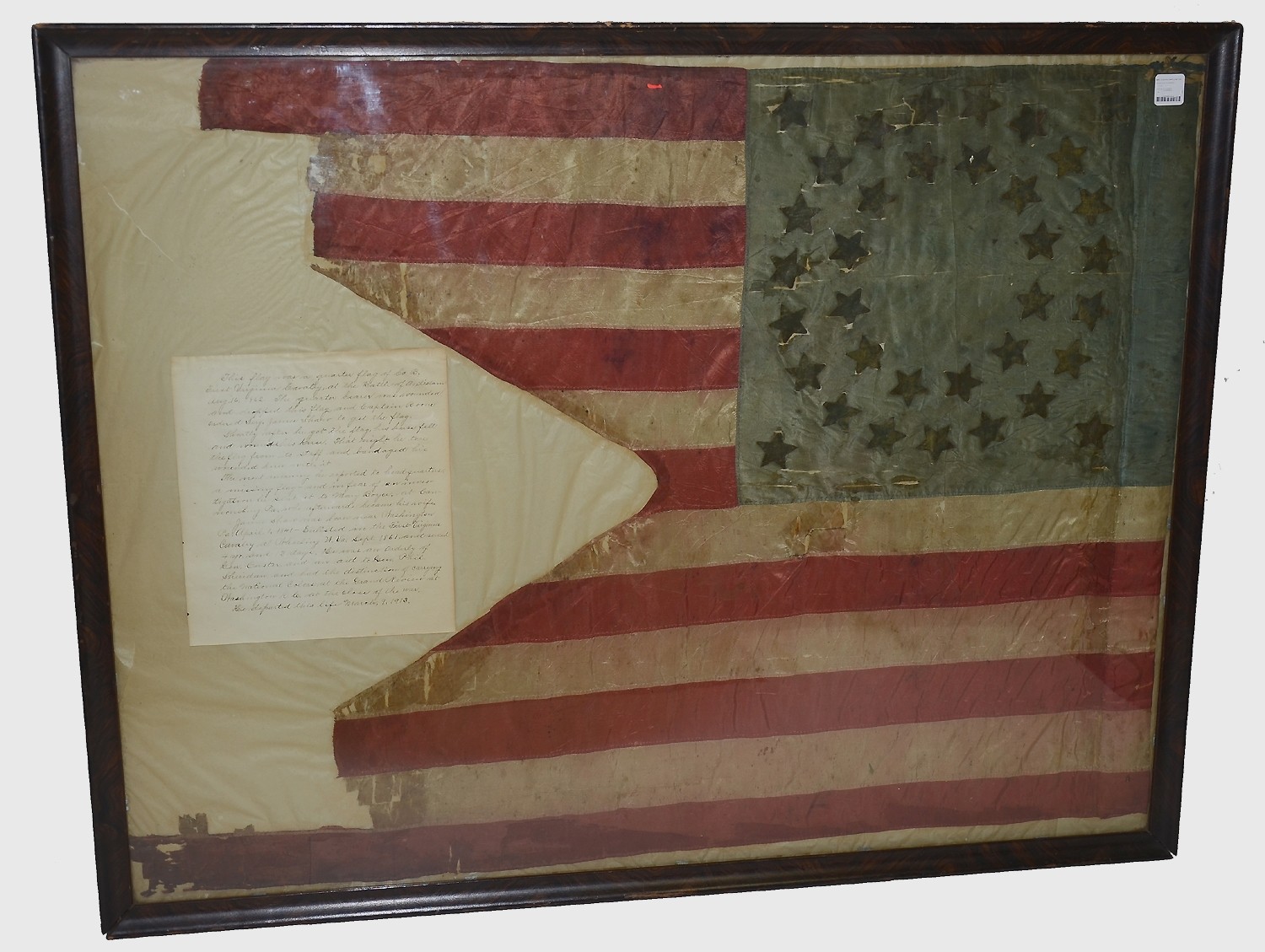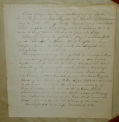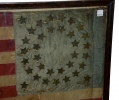site search
online catalog
DOCUMENTED CIVIL WAR REGULATION CAVALRY GUIDON OF COMPANY B, FIRST WEST VIRGINIA CAVALRY WITH A GREAT FAMILY LETTER

$14,000.00 SOLD
Quantity Available: None
Item Code: 1030-24
The First West Virginia Cavalry (or First Virginia (Loyal) Cavalry) has a great fighting record. Recruited in northwest Virginia, western Pennsylvania and eastern Ohio starting in July 1861, elements of the regiment first saw action at Carnifex Ferry in September 1861 and the regiment served to the very end of the war, fighting as part of Custer’s Division at Dinwiddie Court House, Five Forks, Sailor’s Creek and Appomattox. Until June 1863 the regiment often served in smaller detachments against guerillas and partisans, including Mosby. In June they joined the cavalry corps of the Army of the Potomac and at Gettysburg, as part of Elon Farnsworth’s brigade they took part in the suicidal charge ordered by Gen. Hugh Judson Kilpatrick against Confederate infantry on July 3. In early 1864 they joined the Army of West Virginia, taking part in several raids and the attack on Lynchburg, before transferring to the Shenandoah, fighting at Opequon, Cedar Creek and Fisher’s Hill, among other engagements. In early 1865 they took part in the destruction of Early’s army and then moved join the final push against Lee.
This guidon first surfaced in 2008 in an online auction and later passed through the hands of Cowan’s auction in Ohio. Framed with a wonderful letter of provenance, the identification of the guidon is dead-on to Company B of the 1st West Virgina, even if some of the service details of the soldier who got it home are a bit garbled.
The flag follows the specifications for stars and stripes guidons of January 1862. Measuring roughly 27 by 35 ½ inches, the flag is constructed of heavy silk, with a sleeve for the guidon pole made by doubling the canton and fly. The canton is light blue, as is correct, and has 12 stars in a circle, surrounded by another 19 in an outer ring, and 4 more in the corners. The stars now appear as dark blue, but this is likely the ground for the original gold paint or gold leaf, which created the regulation gilt stars.
The flag shows some losses at the fly end, common in a flag actually used, but is in very much better condition than most that have seen service in the field. It is framed with the canton on the right and a letter of provenance at left between the forks. The letter dates after the death in 1913 of the veteran who kept it, likely soon after, and the framing seems to date from the same period. The letter is typical of a family trying to recall what the soldier had told them of the flag and his own service. In their account they refer the veteran rescuing the flag after a “quarter bearer” was wounded, which is probably a confused memory of a “color bearer,” which likely explains why they call it a “quarter flag” as well. They connect his possession of the flag with that incident and place it at the Battle of Antietam, which they erroneously date August 16, 1862.
A full transcript of the letter follows:
This flag was a quarter flag of Co. B. First Virginia Cavalry at the Battle of Antietam Aug 16, 1862. The quarter bearer was wounded and dropped this flag, and Captain Boone ordered Serg. James Shaw to get the flag. Shortly after he got the flag, his horse fell and wounded his knee. That night he tore the flag from the staff and bandaged his wounded knee with it. The next morning he reported to headquarters a missing flag and in fear of an investigation he sent it to Mary Boyce at Cannonsburg, Pa who afterward became his wife. James Shaw was born near Washington, Pa April 1, 1841 - Enlisted in the First Virginia Cavalry at Wheeling, W. Va. Sept 1861 and served 4 years and 13 days. He was an Orderly of Gen. Custer and an aid to Gen. Phil Sheridan and had the distinction of carrying the National Colors at the Grand Review at Washington, D. C. at the close of the war. He departed this life March 8, 1913.
Genealogical and general service details check out. Mary Boyce was the first wife of James B. Shaw. He was a native of Washington County, PA, and enrolled there on 29 August 1861 at age 21. He joined Co. B of the 1st West Virginia cavalry as a private and served at that rank until he reenlisted as a veteran in December 1863, after which he was promoted to sergeant. He is listed as a Quartermaster Sergeant with a company designation rather than a regimental association. This was non-regulation, but became common, especially in mounted units where there was so much more gear to keep track of. From May to August 1863 he seems to have been detached as a Hospital nurse and in October he was apparently returning to the regiment since we find him in a dismounted camp. In early 1865 he did some duty with a recruiting detail, but returned to the regiment and appears on the muster out roll of 8 July 1865. The regiment did serve under Custer and Sheridan, but details such as being an orderly to Custer or aide to Sheridan (an officer’s role) may involve some exaggeration, or may yield something to further investigation.
Details about Shaw’s retrieval of the flag and use of it to bind an injured leg have the ring of truth because of their specificity, and practicality, but have problems. Antietam was fought in September 1862, of course, not August; and, Captain Boon did not join the unit until August 1863. But, there is a very good chance the story preserves some kernels of truth, even if the precise time or location has been garbled. The number of stars on the flag does not help us date it much. West Virginia had been maneuvering to join the Union long before its final admission in June 1863, in fact since 1861, and no flag maker with any business sense would make flags knowing they would soon be obsolete. In fact, one might argue that a West Virginia regiment would specifically want a flag with 35 stars.
Regardless of the exact date Shaw sent or brought it home, the identification of the guidon with a company in one of the most active Union cavalry units is an absolute lock. It also fitting that Shaw, who the family remembers has having reported the flag “lost” and sending it home, ended up being the company quartermaster sergeant, who was in charge of its gear and equipment. This is a seldom-offered chance to acquire a flag that combines great history, artistic appeal, and the romance of cavalry. [sr]
Frame with glass measures 37 3/4" x 30". Click here for our policy for shipment of framed items containing glass.
Extra shipping required.
~~~~~~~~~~~~~~~~~~~~~~~~~~~~~~~~~~
THIS ITEM, AS WITH ALL OTHER ITEMS AVAILABLE ON OUR WEB SITE,
MAY BE PURCHASED THROUGH OUR LAYAWAY PROGRAM.
FOR OUR POLICIES AND TERMS,
CLICK ON ‘CONTACT US’ AT THE TOP OF ANY PAGE ON THE SITE,
THEN ON ‘LAYAWAY POLICY’.
THANK YOU!
Inquire About DOCUMENTED CIVIL WAR REGULATION CAVALRY GUIDON OF COMPANY B, FIRST WEST VIRGINIA CAVALRY WITH A GREAT FAMILY LETTER
For inquiries, please email us at [email protected]
Most Popular
Historical Firearms Stolen From The National Civil War Museum In Harrisburg, Pa »
Theft From Gravesite Of Gen. John Reynolds »
Cavalry Carbine Sling Swivel »
Fine Condition Brass Infantry Bugle Insignia »
featured item
HISTORICAL FIREARMS STOLEN FROM THE NATIONAL CIVIL WAR MUSEUM IN HARRISBURG, PA
Please click on the photograph above to view a flyer containing information regarding a Model 1860 Henry Rifle and pair of cased presentation Colt Revolvers identified to Secretary of War Simon Cameron which were stolen from the museum on February… . Learn More »







